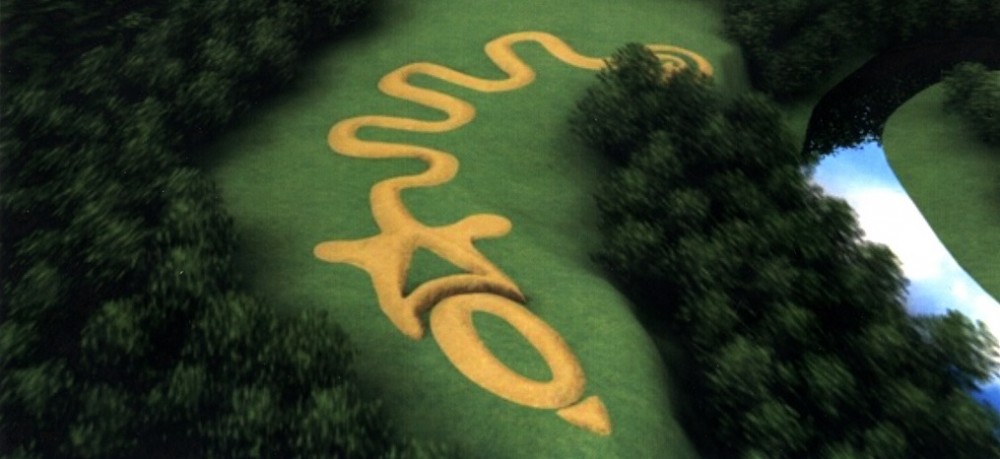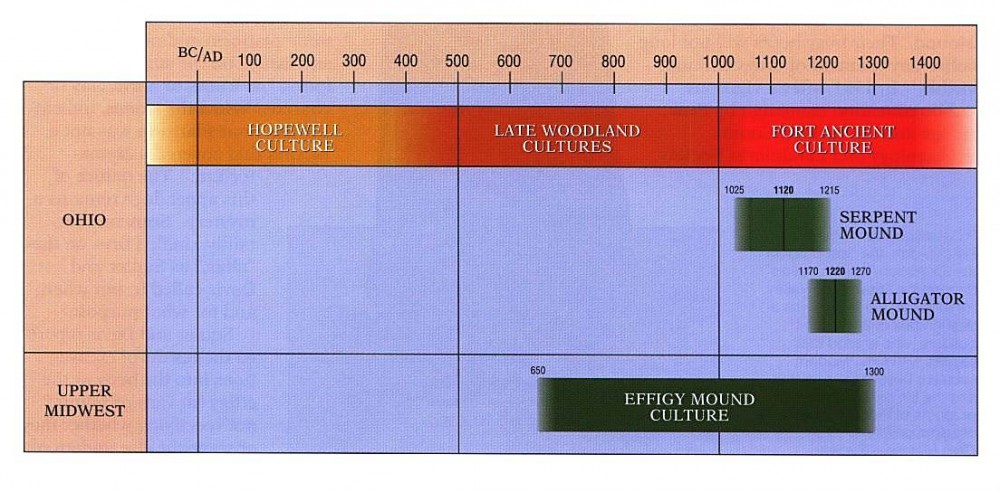
CERHAS rendering of Serpent Mound
Sometimes it seems like everything about Serpent Mound is shrouded in mystery — or at least controversy. Just about everyone agrees that the mound does, indeed, represent a gigantic serpent, but beyond that the answers to even basic questions, such as who built it, still are being debated. At the Midwest Archaeological Conference held last month in Columbus, Bill Romain presented a paper entitled “Serpent Mound Project Results 2013.” His co-authors included William Monaghan (Indiana University), Jarrod Burks (Ohio Valley Archaeology, Inc.), Michael Zaleha (Wittenburg University), Karen Leone (Gray and Pape, Inc.), Tim Schilling (Midwest Archaeological Center), Al Tonetti (ASC Group), Matthew Purtill (Gray and Pape, Inc.) and Edward Herrmann (Indiana University). The results presented by Bill were not limited to a discussion of the Serpent’s age, but since that’s the only aspect of his team’s work that I disagree with that’s the focus of my November column in the Columbus Dispatch and this blog post. Bill has been arguing for years that the Serpent was built by the Hopewell culture. I have argued that it makes much more sense as a Fort Ancient culture effigy mound.

View of the initial 1991 excavation into a previously disturbed portion of Serpent Mound interpreted as one of Putnams trenches. From left to right, DeeAnne Wymer, Terry Cameron, Brad Lepper, Robert Fletcher.
In 1991, I worked with a team of amateur and professional archaeologists that recovered bits of charcoal from the Serpent. The charcoal produced two radiocarbon dates both around A.D. 1120. This roughly corresponds to the age of the vast majority of other effigy mounds in eastern North America, including Ohio’s other effigy mound — Licking County’s so-called Alligator. Also, the art of this period throughout eastern North America is rich in serpent symbolism. So, even without the radiocarbon dates, Serpent Mound fits rather comfortably into the context of what was happening throughout eastern North America at about this same time. I think it’s fair to say that, over the last two decades, this interpretation has become accepted by most North American archaeologists — but all scientific knowledge is provisional and subject to rejection or revision in the light of new data or better arguments.
In his presentation, Bill stated five principal reasons for thinking the Serpent was built by the Adena culture, circa 600 B.C. to A.D. 100:
1. As part of his team’s 2011 investigation, they recovered several bits of charcoal from soil cores, which produced radiocarbon ages that average around 300 B.C.
2. Serpent iconography is present in Adena and Hopewell art.
3. His team recovered no Fort Ancient artifacts in their soil cores.
4. He expressed the opinion that the radiocarbon dates obtained for the Serpent in 1991 do not relate to the original construction of the mound, because they came from near the surface and were either in a disturbed context or relate to a re-furbishing of the mound in Fort Ancient times.
5. The design of the mound appears to incorporate “Adena and Hopewell metrics.”
I’m not convinced by Bill’s arguments and here’s why:
1. The charcoal was not found in a secure context. The fragments Romain’s team recovered from soil cores may be from the Adena occupation that Putnam discovered at the site. The Fort Ancient builders of Serpent Mound may have dug into the buried remains of Adena cooking fires while excavating for the earth used to build the mound and then accidentally incorporated some of that charcoal into the mound.
2. Serpent imagery is virtually absent in Adena art. The only example Romain mentioned in his presentation was the vaguely serpentine pattern on the loin cloth of the man on the Adena Pipe. There are serpents in Hopewell art, but just about every other animal that lived in Ohio also is represented. Serpents appear to have been regarded by the Hopewell as, at best, just one among many potential spirit guardians.

Sandstone palette engraved with two intertwined serpent monsters from a Mississippian mound in the state of Mississippi. Ohio Historical Society collections.
In contrast, serpents are a hugely important component of Mississippian symbolism. Especially important examples include rattlesnake palettes, rattlesnake engravings on shell gorgets, and the amazing Birger figurine. Of course the Fort Ancient is not, strictly speaking, a Mississippian culture, but these people did live in a Mississippian world and to a greater or lesser extent they were active participants in that world and would have shared much of its cosmology.
3. It is unusual to recover artifacts in soil cores generally and anyway, Putnam didn’t report finding any artifacts at all in his excavation of the Serpent. Romain did not say whether his team recovered any Adena or Hopewell artifacts in their cores, but if he had I think he would have mentioned it.
4. The soil samples we recovered in 1991 and from which we obtained the charcoal that gave us the Fort Ancient dates were by no means from near the surface. Moreover, in our excavation profile we observed no evidence of any re-furbishing of the mound other than Putnam’s restorations in the 1880s. There was a distinct boundary between the intact mound deposits and the material added by Putnam, so we’re reasonably sure our samples came from deep within the original mound.

Photograph of the 1991 excavation into Serpent Mound compared to our stratigraphic profile. The darker layer at the top (including both strata I & II) is earth added by Putnam when he restored the mound. The light colored layer (including both strata III & IV) is the remnant of the original mound. The profile shows the locations of the two soil samples, 4A and 5A, from which we recovered charcoal. Both samples produced dates of around AD 1120. Modified from Figures 9 and 10 in Fletcher et al. 1996.
5. The alleged use of “Adena and Hopewell metrics” by the builders of Serpent Mound is an interesting, but controversial claim. Even if true, it would only demonstrate that the mound was built during or after the Adena and Hopewell eras. The modern foot appears to have been adopted in Europe in the early 12th century A.D. and structures incorporating this “Norman metric” are still being designed and built today.
So, who built Serpent Mound?
We still don’t know for sure. Given our inability so far to recover and date charcoal clearly related to the construction of the mound, future investigations may attempt to resolve the controversy by using new dating techniques, such as Optically Stimulated Luminescence, to provide a definitive answer. Until that happens, I think the existing data point to the Fort Ancient culture as the most likely builders of the Great Serpent. If it’s an Adena mound it’s a wildly precocious anomaly, whereas if it’s a Fort Ancient mound, it is still an anomaly, but it’s not unprecedented — it fits within a broad, regional tradition of effigy mound building that includes Alligator Mound and the Kern stone serpent effigies located in the Little Miami Valley.

Timeline showing the overlap of radiocarbon dates for Serpent Mound, Alligator Mound and the hundreds of effigy mounds in the upper Midwest. The specific cultural connections between the Ohio mounds and those of Wisconsin and Iowa are not strong, but the people in Ohio could not have been entirely unaware of the revolution in mound-building taking place in the upper Mississippi valley. Graphic from Lepper 2001.
I look forward to reading the final report of the investigations by Romain’s team, which undoubtedly will include more data and a fuller presentation of their interpretations. Even if I end up still disagreeing with their assessment of the age of the Serpent, I am sure I will learn a lot that I didn’t know before about this amazing mound.
For further reading: Burks, Jarrod 2012 Ohio’s Great Serpent Mound surveyed. ISAP News 32, pp. 6-7. Fletcher, Robert, Terry Cameron, Bradley T. Lepper, Dee Anne Wymer, and William Pickard 1996 Serpent Mound: a Fort Ancient icon? Midcontinental Journal of Archaeology 21:105-143. Lepper, Bradley T. 1998 Great Serpent. Timeline 15(5):30-45. 2001 Ohio’s Alligator. Timeline 18(2):18-25. Lepper, Bradley T. and Tod A. Frolking 2003 Alligator Mound: geoarchaeological and iconographical interpretations of a Late Prehistoric effigy mound in central Ohio, USA. Cambridge Archaeological Journal 13(2):147-167. Romain, William F. 2000 The Serpent Mound. In Mysteries of the Hopewell: astronomers, geometers, and magicians of the eastern Woodlands, pp. 233-253. University of Akron Press. Weintraub, Daniel and Kevin R. Schwarz 2013 Long shadows over the valley: findings from ASC Group’s excavations at Serpent Mound State Memorial. Current Research in Ohio Archaeology 2013.
Brad Lepper